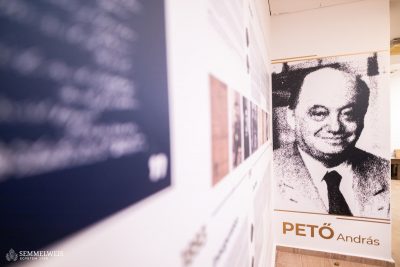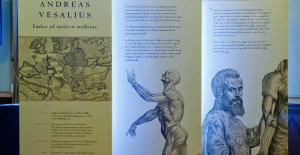 An exhibition on the founder of modern anatomy, Andreas Vesalius is hosted by Semmelweis Salon this week. The exhibition, consisting of five roll-up banners, was prepared by the Belgian Ministry of Foreign Affairs in commemoration of the 500th anniversary of the birth of Andreas Van Wesel.
An exhibition on the founder of modern anatomy, Andreas Vesalius is hosted by Semmelweis Salon this week. The exhibition, consisting of five roll-up banners, was prepared by the Belgian Ministry of Foreign Affairs in commemoration of the 500th anniversary of the birth of Andreas Van Wesel.
In his opening speech Dr. Ágoston Szél said that the birth of Vesalius could also be considered as the birth of anatomy.
He also revealed that the Central Library of Semmelweis University keeps a copy of De humani corporis fabrica (On the Fabric of the Human Body), the most famous book of Vesalius written in 1543. In his speech he emphasized how important it was to deal with the current public opinion on the role of anatomy in medical education.
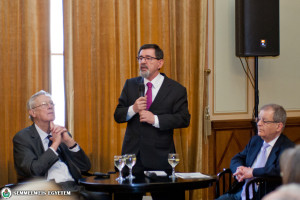 All educational reforms raise the question about the necessity of the incorporation of anatomy in the curriculum. Several Western European countries have drastically decreased the number of anatomy lessons, while others have entirely omitted the subject from the curriculum. However, Dr. Ágoston Szél mentioned that Semmelweis University was proud to commit to the traditional way of education by providing a fair amount of anatomy lessons to its students.
All educational reforms raise the question about the necessity of the incorporation of anatomy in the curriculum. Several Western European countries have drastically decreased the number of anatomy lessons, while others have entirely omitted the subject from the curriculum. However, Dr. Ágoston Szél mentioned that Semmelweis University was proud to commit to the traditional way of education by providing a fair amount of anatomy lessons to its students.
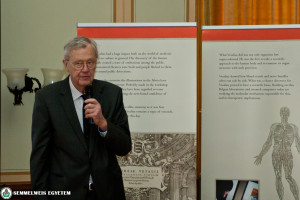 Dr. Raphael Suy, professor emeritus of the University of Leuven gave a presentation titled “Renovation of Anatomy: The Sacred Mission of Vesalius”. The presentation focused on Vesalius’ masterpiece, De humani corporis fabrica which consists of seven books, altogether numbering 660 pages and 300 illustrations. The book is based on his extensive research, as well as dissections and autopsies carried out on human bodies at the University of Padua. Writing such an ambitious book did not only require research and practical studies, but Vesalius’ high qualification, self confidence and passion for anatomy as well.
Dr. Raphael Suy, professor emeritus of the University of Leuven gave a presentation titled “Renovation of Anatomy: The Sacred Mission of Vesalius”. The presentation focused on Vesalius’ masterpiece, De humani corporis fabrica which consists of seven books, altogether numbering 660 pages and 300 illustrations. The book is based on his extensive research, as well as dissections and autopsies carried out on human bodies at the University of Padua. Writing such an ambitious book did not only require research and practical studies, but Vesalius’ high qualification, self confidence and passion for anatomy as well.
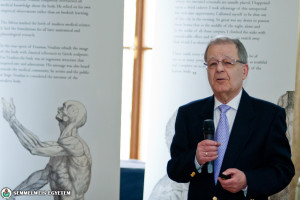 In his presentation “Embryology, Birth and Development of Human Anatomy” Dr. Tibor Wenger, professor emeritus of the Department of Human Morphology and Developmental Biology gave examples on how accurately Vesalius was able to model various parts of the human body, such as the intestinal system or the circulatory system. He also gave a cursory overview of the development of anatomical education originating from the famous lecture hall at the University of Padua. Nowadays education is aided by several modern technologies, thus microscopical examinations, functional, clinical and computerised solutions for the study of anatomy support and complement the irreplaceable practice of autopsy.
In his presentation “Embryology, Birth and Development of Human Anatomy” Dr. Tibor Wenger, professor emeritus of the Department of Human Morphology and Developmental Biology gave examples on how accurately Vesalius was able to model various parts of the human body, such as the intestinal system or the circulatory system. He also gave a cursory overview of the development of anatomical education originating from the famous lecture hall at the University of Padua. Nowadays education is aided by several modern technologies, thus microscopical examinations, functional, clinical and computerised solutions for the study of anatomy support and complement the irreplaceable practice of autopsy.
The exhibition can be visited between 13th and 17th April in Semmelweis Salon by prior appointment (contact details: +36 20/825 9835 or +36 20 825 9829). The exhibit will travel across several countries in the months to follow.
Pálma Dobozi
Photo: Attila Kovács, Semmelweis University
Translated by: Ágnes Raubinek
